By Scott Westerman
 In every boy’s life there is a Ralph Parker “Red Ryder Christmas“, the year when he got that one present that forever defined his youth. My Red Ryder Christmas happened in 1966.
In every boy’s life there is a Ralph Parker “Red Ryder Christmas“, the year when he got that one present that forever defined his youth. My Red Ryder Christmas happened in 1966.
At 1926 Hampton Court, Christmas season officially began with the tree. For many years it was the real thing, purchased at the YMCA “Y’s Men’s” lot out near the Westland Shopping Center. Later, we bought one of the early faux trees, green and perfect, never shedding a needle and never in need of water. But to this day, the aroma of pine instantly transports me back to the frozen Michigan Decembers of my youth.
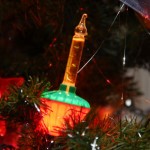 Decorating the tree was a family affair. We each had our favorite ornaments, which we placed with the attention to detail of an artisan among the perfectly appointed strings of multi-colored incandescent lights. These were the days before those rotten tiny white lights had become the norm. You know the ones, where a single dud knocked out the entire string. You spent an hour plugging the spare into every socket, invariably discovering the bad one at the very end of your effort. In 1966, our lights were were night-light quality red, blue and green bulbs, 5 watt indoor-only power eaters, as big as your thumb. We screwed them into sockets big enough to hold alternatives, like the liquid filled test tube models that glowed at the base with tiny bubbles dancing upwards. We never had anything like these bubblers on our trees. But our Ohio cousins did. And it was there that we got our first look at a sliver aluminium tree that changed colors in step with a rotating spotlight gel at it’s base.
Decorating the tree was a family affair. We each had our favorite ornaments, which we placed with the attention to detail of an artisan among the perfectly appointed strings of multi-colored incandescent lights. These were the days before those rotten tiny white lights had become the norm. You know the ones, where a single dud knocked out the entire string. You spent an hour plugging the spare into every socket, invariably discovering the bad one at the very end of your effort. In 1966, our lights were were night-light quality red, blue and green bulbs, 5 watt indoor-only power eaters, as big as your thumb. We screwed them into sockets big enough to hold alternatives, like the liquid filled test tube models that glowed at the base with tiny bubbles dancing upwards. We never had anything like these bubblers on our trees. But our Ohio cousins did. And it was there that we got our first look at a sliver aluminium tree that changed colors in step with a rotating spotlight gel at it’s base.
But I digress.
The year was 1966. We were still Methodists then and my dad signed us on to read the biblical Christmas Story in the cavernous First Methodist Church in Ann Arbor. It had, and still has, one of those big, dark, stained glass sanctuaries that seemed skyscraper tall to an eleven year old. It was as if God himself had crafted it to remind us to pay attention to the pastor and behave, or there would be hell to pay.
Not everything about the place was frightening. I liked Methodist Youth Fellowship. Here was where the cool kids in our grade spent Wednesday evenings, learning about things like character and ethics (and sex education before that was taught at school). Attendance was casually monitored so Joey Morrison and I would sometimes cut class to listen to Bob Seger records and sneak down the street to smell the incense and admire the black-light artwork at the Middle Earth head shop.
But those days were still ahead of me. After surviving our family reading in front of what felt like the entire population of Washtenaw County, we repaired to Chelsea to visit Grandma and Grandpa Westerman. Grandpa did his Christmas Shopping at the local drug store and this was the year he went out on a limb and bought Judy and me squirt guns. They hadn’t perfected the high pressure super soaker yet and these babies leaked as much water out of the seams as came out of the barrel, but there were still effective. We weren’t allowed to use them in the house.
We were allowed to open one small present on Christmas Eve. It was like a shot of caffeine that ensured a near sleepless night as we anticipated the treasures that awaited us in the morning.
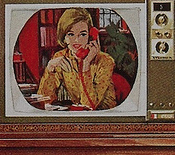 Our family enjoyed middle class affluence in the 60s. My most memorable Christmas took place after Kennedy but before the riots and the 68 Convention. It was a time when local radio stations signed off at sunset, when FM was still a novelty and the kids who had color TV’s made fast friends on Saturday mornings. Our color TV didin’t arrive until the next Spring, and even when it did, it wasn’t quite right. The horizontal hold required constant adjustment, something I learned how to do by feel. The picture tube wasn’t rectangular, the color controls were turned up to emphasize the flavor of the eye candy, and consumption (at least at our house) was limited and had to be agreed upon by all four of us.
Our family enjoyed middle class affluence in the 60s. My most memorable Christmas took place after Kennedy but before the riots and the 68 Convention. It was a time when local radio stations signed off at sunset, when FM was still a novelty and the kids who had color TV’s made fast friends on Saturday mornings. Our color TV didin’t arrive until the next Spring, and even when it did, it wasn’t quite right. The horizontal hold required constant adjustment, something I learned how to do by feel. The picture tube wasn’t rectangular, the color controls were turned up to emphasize the flavor of the eye candy, and consumption (at least at our house) was limited and had to be agreed upon by all four of us.
A Charlie Brown Christmas was only on it’s second run, and Peter Robbins, whose trademark Arggggh would be used for a decade as Charlie Brown’s anguished scream had just turned ten years old. Burl Ives was in his third year intoning the snowman narration for the stop action animated Rudolph the Red Nosed Reindeer. And Mr. Magoo’s Christmas Carol held the record as the longest running holiday program, specifically created for television.
All of these things spun around my eleven year old brain that Christmas Eve. My bedroom was over the garage and my insistence on a hide-a-bed made for particularly cold nights without the protection of a box spring beneath my thin mattress. But it wasn’t the temperature that kept me awake. It was the anticipation. This was the currency created and sold by businesses large and small in countless advertisements for Mattel and Marx and Ohio Art. Creepy Cralwers, Vacu-Form, Easy Bake Ovens, Rock em Sock em Robots and The Game of Life all made their debut in this decade. And every kid went to bed imagining what might be inside the boxes that would magically appear at the agreed-upon hour when we were allowed to wake our parents and begin our annual exercise in conspicuous consumption.
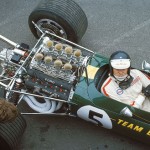 On Christmas Morning, 1966, there was really only one thing on my mind: Auto racing. I was a rabid fan of the Indy 500, of the Ford GT, the 24 hours of Le Mans and the cigar shaped formula one cars drivin by super heroes with names like A.J. Foyt and Jimmy Clark. My passion was primed by Davy Harbison, an early adopter of slot car racing. Whenever I could wrangle in invitation, I was in his basement, control trigger in hand, doing my best to try and keep a 1/32nd scale Porsche from flying off the track.
On Christmas Morning, 1966, there was really only one thing on my mind: Auto racing. I was a rabid fan of the Indy 500, of the Ford GT, the 24 hours of Le Mans and the cigar shaped formula one cars drivin by super heroes with names like A.J. Foyt and Jimmy Clark. My passion was primed by Davy Harbison, an early adopter of slot car racing. Whenever I could wrangle in invitation, I was in his basement, control trigger in hand, doing my best to try and keep a 1/32nd scale Porsche from flying off the track.
Slot car racing required skill. Hand eye coordination, patience and tenacity were all focused on a small hunk of plastic, metal and rubber weighing less than half a pound. The best practitioners knew just how much juice to send through the silver tape on the tracks and into the commutators of the Pittman DC motors that lobbed these micro-mobiles around Davy’s 4 X 8 foot oval.
I was a lousy driver. Not having my own car and being more focused on the Revere tape recorder my grandfather had given me, I had not developed skills. So I usually sat at the bottom of the ziggurat,with J. Morris, Mark Morehouse, Tim Roos and the Harbisons way ahead of me.
But that was all about to change.
I guessed it the moment I bounded into the living room and saw the box leaning up against our Sony HiFi. It took great self control not to rip the wrapping paper off of it right away.
But I knew the drill. We started with the stuff that came from our out of town relatives. The inevitable pralines from Grandpa Perry, the socks and shirts and other stuff that would soon be consumed or out-grown came first. And we each opened one present in turn, beginning with the youngest (my sister Judy) and ending with the oldest (my mother).
It felt like forever, but the moment finally came when my parents pointed to the big box. Exhibiting a maturity and patience I didn’t feel, I slowly lowered the box to the floor and began to carefully remove it’s wrapping.
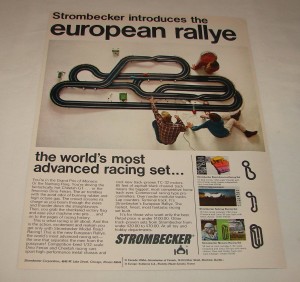 What I saw was beyond my wildest dreams. It was a Strombecker European Rallye Road Racing Set. It came with 65 feet of two lane track, two exquisite cars, a Dino Ferrari and a Cheetah GT, Strombecker’s Pittman knock-off TC-32 motors and the associated power supply and controllers. The best I had dared to hope for was an oval track like Davy had, but this was the state of the art. It cost a hundred bucks, an exorbitant sum, equivalent to $650 dollars in 2010 money. And it made me instantly the most popular kid in the neighborhood.
What I saw was beyond my wildest dreams. It was a Strombecker European Rallye Road Racing Set. It came with 65 feet of two lane track, two exquisite cars, a Dino Ferrari and a Cheetah GT, Strombecker’s Pittman knock-off TC-32 motors and the associated power supply and controllers. The best I had dared to hope for was an oval track like Davy had, but this was the state of the art. It cost a hundred bucks, an exorbitant sum, equivalent to $650 dollars in 2010 money. And it made me instantly the most popular kid in the neighborhood.
When Davy heard about it, he came over and helped me put the thing together. It was a twisting, weaving roller coaster of a track with a chicane, guard rails and lap counters. And it was heaven. I don’t remember eating anything that day. And I invested every waking hour until school started in the cockpit.
Those of you who were there know the sensation. When you put the controller in your hand, your body started to reduce in size, just exactly like the crew of the Proteus in the 1966 film Fantastic Voyage . You entered a zen-like state of consciousness, in two places at once. One was high above the track, watching as if in a helicopter commanding a full view of the proceedings. The other was looking out of the clear plastic windshield, strapped into an imaginary racing seat behind the same powerful 7 liter Ford engine that fired the legendary GT40, the vehicle that had won it’s first of four straight Le Mans victories the previous summer.
Your fingers pressed the controller with a surgical precision as your eyes and ears collaborated to devine the edge of the g-force envelope where the literal rubber met the road. I would learn later, when I first drove a Winston Cup Car at Charlotte Motor Speedway, that the mental sensation was the same. The only difference was the visceral press of gravity that slammed your body to the right as your cornered on Charlotte’s 24 degree banks. The ultimate in vicarious thill.
Six years later, when I was failing high school geometry, I would be unable to recall the natural, instinctive vectors and angles that my brain could effortlessly calculate in 1966. The fact that I had a horrible teacher probably also played a role. But long before that watershed moment, I knew what it felt like to have the native intelligence of an astronaut in the Manned Space Program. I was one with Jim Lovell and Buzz Aldrin, using the same senses and motor skills in my own earth based version of their November Gemini XII mission. But instead of simply orbiting the Earth, I was a fighter pilot, hurtling along a thin black ribbon with only 4 small rubber tires and my wits standing between victory and defeat.
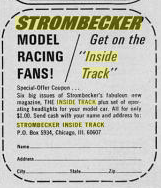 In short order, my car collection expanded to HO scale when J. Morris got a slot car set. I learned to tear down and repair a motor with pit crew speed. And I was one of the few subscribers to Strombecker’s Inside Track magazine when it published its final issue. I read Road & Track with veracity. I grieved when Jimmy Clark was killed and had a birthday party at the Summit Theater in Detroit to watch the film Grand Prix in Cinerama. Racing was in my blood and I couldn’t get enough of it.
In short order, my car collection expanded to HO scale when J. Morris got a slot car set. I learned to tear down and repair a motor with pit crew speed. And I was one of the few subscribers to Strombecker’s Inside Track magazine when it published its final issue. I read Road & Track with veracity. I grieved when Jimmy Clark was killed and had a birthday party at the Summit Theater in Detroit to watch the film Grand Prix in Cinerama. Racing was in my blood and I couldn’t get enough of it.
The slot car craze didn’t last long. Strombecker sold out to Bachman in the 70s and by the time my kids were playing games, it was the era of the Super Mario Brothers. My own interests evolved mini-bikes, percussion, rock n roll and radio. And before long my racing days had faded in to the far recesses of my memory.
As the years have passed the Christmas season has mellowed and I’ve learned that the act of giving brings exponentially greater joy than receiving. But 1966 will be forever etched in my memory as the most exciting, magical and memorable Christmas of all time; The Christmas I was transformed from a kid into a race car driver.
And to this day, my Strombecker European Rallye Road Race Set remains the best Christmas present I ever got.